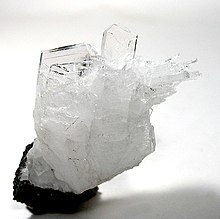Yugawaralite
Appearance
| Yugawaraite | |
|---|---|
 | |
| General | |
| Category | Zeolite group |
| Formula (repeating unit) | CaAl2Si6O16 · 4H2O |
| Crystal system | Monoclinic |
| Identification | |
| Color | Colorless, pink, or white |
| Cleavage | Poor, indistinct |
| Tenacity | Very brittle |
| Mohs scale hardness | 4.5-5 |
| Luster | Vitreous, pearly |
| Streak | White |
| References | [1] |
Yugawaralite is a clear or pinkish mineral of the Zeolite group.[1][2] It was first described by Sakurai and Hayashi (1952) near a waterfall by some hot springs near Yugawara.[3]
Etymology
Yugawaralite is named after the town Yugawara, where it was found.[1]
Location
Yugawaralite is found in Japan, India, and other locations. In Japan, yugawaralite is found on Honshu, where Yugawara is the type locality. In India, it is found in small amounts. Other locations where it has been found is Washington, Alaska, Yellowstone National Park, British Columbia, Iceland, Sardinia, and Reunion island.[2]
In Alaska
In Alaska, yugawaralite is found about 40 miles (64 km) east of Fairbanks, Alaska. In this site, yugawaralite has been recorded up to 8 millimetres (0.31 in) long.[3]
References
- ^ a b c "Yugawaralite". www.mindat.org. Retrieved 2022-08-03.
- ^ a b "Yugawaralite Value, Price, and Jewelry Information". International Gem Society. Retrieved 2022-08-03.
- ^ a b Eberlein, G. Donald; Erd, R.C.; Weber, Florence; Beatty, L.B. (1971). "New Occurrence OF Yugawaralite from the Chena Hot Springs Area, Alaska" (PDF). The American Mineralogist. 56 (September–October 1971). Retrieved 5 August 2022.
